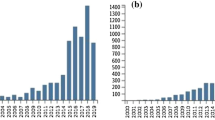Abstract
Seismology has several features that suggest it is a highly internationalized field: the subject matter is global, the tools used to analyse seismic waves are dependent upon information technologies, and governments are interested in funding cooperative research. We explore whether an emerging field like seismology has a more internationalised structure than the older, related field of geophysics. Using aggregated journal-journal citations, we first show that, within the citing environment, seismology emerged from within geophysics as its own field in the 1990s. The bibliographic analysis, however, does not show that seismology is more internationalised than geophysics: in 2000, seismology had a lower percentage of all articles co-authored on an international basis. Nevertheless, social network analysis shows that the core group of cooperating countries within seismology is proportionately larger and more distributed than that within geophysics. While the latter exhibits an established network with a hierarchy, the formation of a field in terms of new partnership relations is ongoing in seismology.
Similar content being viewed by others
References
BORGATTI, S. P., M. G. EVERETT, L. C. FREEMAN (2002), Ucinet for Windows: Software for Social Network Analysis. Harvard: Analytic Technologies.
CARPENTER, M. P., F. NARIN (1973), Clustering of scientific journals. Journal of the American Society of Information Science, 24: 425-436.
COZZENS, S. E., L. LEYDESDORFF (1993), Journal systems as macro-indicators of structural change in the sciences. In: A. F. J. VAN RAAN, R. E. DE BRUIN, H. F. MOED, A. J. NEDERHOF, R. W. J. TIJSSEN (Eds), Science and Technology in a Policy Context, Leiden, DSWO Press, (1993), pp. 219.233.
DOREIAN, P. (1986), A revised measure of standing of journals in stratified networks. Scientometrics, 11: 63-72.
DOREIAN, P., T. J. FARARO (1985), Structural equivalence in a journal network. Journal of the American Society of Information Science, 36: 28-37.
GIBBONS, M., C. LIMOGES, H. NOWOTNY, S. SCHWARTZMAN, P. SCOTT, M. TROW (1994), The New Production of Knowledge: The Dynamics of Science and Research in Contemporary Societies, Sage Publications, London.
GLäNZEL, W. (2001), National characteristics in international scientific co-authorship relations, Scientometrics, 51: 69-115.
HAMERS, L., Y. HEMERYCK, G. HERWEYERS, M. JANSSEN, H. KETERS, R. ROUSSEAU, A. VANHOUTTE (1989), Similarity measures in scientometric research: The Jaccard Index versus Salton's cosine formula. Information Processing & Management, 25: 315-318.
LEYDESDORFF, L. (1987), Various methods for the mapping of science. Scientometrics, 11: 291-320.
LEYDESDORFF, L., S. E. COZZENS (1993), The delineation of specialities in terms of journals using the dynamic journal set of the Science Citation Index, Scientometrics, 26: 133-154.
LEYDESDORFF, L. (2001), The Challenge of Scientometrics: The Development, Measurement, and Self-organization of Scientific Communications. USA: Universal Publishers.
MULLINS, N., W. SNIZEK, K. OEHLER (1988), The structural analysis of a scientific paper. In: A. F. J. VAN RAAN (Ed.), Handbook of Quantitative Studies of Science and Technology, pp. 81-106, Amsterdam, Elsevier.
TIJSSEN, R. (1993), A scientometric cognitive study of neural network research: Expert mental maps versus bibliometric maps, Scientometrics, 28: 111-136.
WAGNER, C., L. LEYDESDORFF (2003), Mapping the global network of science: A comparison of 1990 and 2000, forthcoming. Pre-publication version available at http://www.leydesdorff.net/sciencenets.
WOUTERS, P. (1999), The Citation Culture, Amsterdam: Unpublished Ph.D. Thesis, University of Amsterdam.
Author information
Authors and Affiliations
Corresponding author
Rights and permissions
About this article
Cite this article
Wagner, C.S., Leydesdorff, L. Seismology as a dynamic, distributed area of scientific research. Scientometrics 58, 91–114 (2003). https://doi.org/10.1023/A:1025479524390
Issue Date:
DOI: https://doi.org/10.1023/A:1025479524390




